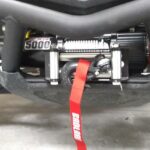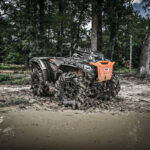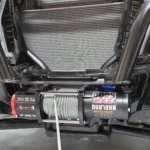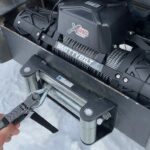If off-road adventurers are reading this article, they are familiar with the potential of a winch under challenging situations on challenging terrains. And as you have landed on this article, it is evident that you are confused between the electric winch and hydraulic winch variants.
The confusion between efficiency, power, and budget will always trouble you to choose between these two versions.
So, to help ease it for you, we are providing you with a brief comparison article on the topic of hydraulic winch vs. electric winch.
Hydraulic Winch
Winches that draw power from an embedded hydraulic system or pump are called hydraulic winches. These types of winches are specifically designed to do some heavy-duty jobs. The technical manufacturing of a hydraulic winch prevents the system from experiencing overheating or structural damage.
If you are using a boat, tow truck, or even an off-roading rig, this is perfect for beginners new to winches. The functionality is easy, and the chances of beginner errors are less with it. Hydraulic winches[1] do not entirely rely on the car’s battery for powering themselves, as their primary operating fuel is the fluid or oil.
Parts of Hydraulic Winch
A hydraulic winch is comprised of parts as follows:
- Hydraulic system with fluid power
- Low or high-speed motor
- Closed multi-disc brake
- Support shaft
- Drum
- Planetary gearbox
- Clutch component (Optional)
- Steel or synthetic rope
Working of a Hydraulic Winch
Hydraulic winches use fluids such as oil to execute their working operations. Fluid power is implemented in the hydraulic system, and a motor pump is installed within the machine and generator.
The power steering pump then creates fluid pressure, which is used for transmitting the power through existing pressure within the oil. If you are going for an offroad adventure to tough terrain, you might believe that the motor of a standard hydraulic winch might not be sufficient to help you pull through those difficult situations.
There is a scope for improvement to the motor by coupling a gearbox that will connect the winch and its cables for carrying the load. The entire system will align itself by operating with a compressed valve. This valve is linked to a pressure line, central spool, pump fluid, and switches.
Using a motor becomes necessary because the hydraulic pump system doesn’t integrate a speed-changing option with the winches. Therefore, integrating a gearbox into the unit will allow you to customize your speed settings for different winching jobs.
There are three types of control valves in a hydraulic winch, which include pressure, directional, and flow control valves. As the name suggests, you can change or control the fluid’s pressure and flow. And, with the directional valve, you can change the direction of the flow as well.
The power section of the hydraulic winch works toward using the pump to transform the fluid’s mechanical energy into hydraulic energy. And the winch operates seamlessly!
Electric Winch
An electric winch, as the name suggests, is powered by electricity from your car’s battery or direct power input. As an off-roader, you must ensure that your vehicle’s battery is sufficiently charged to help you operate the winch under challenging situations.
If you are not a consistent off-roader using a light vehicle for the adventures, then a standard electric winch will do the job for you. It is easy for both beginners and experts to operate an electric winch.
Parts of Electric Winch
An electric winch comprises various components as follows:
- Electric lift motor (An essential part)
- Gearbox
- Chain bags
- Chains
- Hooks
- Transverse drive
- Electric panels
- Drum
- Planetary Gears
- Solenoids
- Remote Control
- Has strollers
- Clutch
- Steel or synthetic cable
Working of an Electrical Winch
Electric winches use an electric motor that takes power from a car’s battery. The current changes on different poles initiate a spin on the magnet, which powers your motor and turns the winch. As electric winches have variants that can withstand heavy-duty jobs, the motor must possess robust strength to handle immense charge.
The winch motor in the system should have flexibility in handling heavier loads. The gears within your electric winch motor will play a significant role in pulling the loads. Most advanced electric winches use a planetary gear system, which works more efficiently with minimal effort.
Planetary gear systems have a mechanism such as a smaller gear rotating around the larger gear, which makes it easy to pull up larger objects. Electric winches have gears depending on their specifications and pulling capacity.
The electric winches are similar to all other electrical machines and can take power from AC and DC sources. Most ATV winches take power from the DC battery of the vehicle itself. But some trailers and trucks connect respective winches to 12V DC power to operate it.
You can also connect it to the AC power of your vehicle when it is in the ignited state. Drawing from the AC source will enhance the efficiency of the electric winch. Even though the electrical winch won’t drain out the complete battery power, it is still advised to have sufficient charge to let the winch operate efficiently.
How to Decide Which Winch to buy?
Here are a few of the factors for you to compare and decide on which is better in the battle of hydraulic winch vs. electric winch.
Cost
The initial equipment cost is higher with electrical winches than with hydraulic winches. But on the other side, the installation is a bit complex with hydraulic winches that might add up to the cost if you are not an expert on it. Electrical winches can be installed quickly!
Moreover, electrical winches also demand low maintenance, while hydraulic winches can be expensive in the long run due to timely maintenance needs.
Weight
An electrical winch is light in weight, as there is no need for extra fittings, pipings, or HPU setup. Hydraulic winches, on the other hand, have a lot of installation parts, which adds to the overall mass and volume. Hence, this adds up to the weight of the winch setup and increases the load on the vehicle.
Load Capacity
Hydraulic winches operate with a more complex mechanism, enabling them to be embedded with heavy load-bearing capacity than electric winches. Electric winches also have varying load-pulling capacities starting from 2000lbs to 13000 lbs or more, depending on brand and specifications. It depends on you to choose the load capacity based on your vehicle and specific needs.
Durability
Hydraulic winches can operate at a vast range of operating temperatures without overheating or operational issues. Hence, they are durable to be used for a long & consistent time. And with timely maintenance, it can last for a very long time.
Electric winches have overheating issues[2] and are limited in how much time you can consistently run them. There are overheating issues in it, and you can overcome them by adding substantial breaks to the pulling effort by the winch.
The build quality is undoubtedly better for hydraulic winches than electric winches. As powerful and intense parts are used in hydraulic winches, the overall build quality must be robust to avoid malfunctions.
Usability With Respect to Vehicle Types
Hydraulic winches are more reliable for heavy trucks and big marine boats, as they mostly have high-duty pulling activities throughout their operations and adventures. It can also be used on a big SUV-style off-roading vehicle but is not necessarily required.
Electric winches are ideal for ATVs, UTVs, and SUVs to fulfill their adventures without any halt. Such winches are available in different load-pulling capacities for customers to choose from, depending on their needs. You can read my article on best electric winches to explore some of the top options in the market
More on electric winch
Verdict
Even if you are a moderate or expert off-roader or an adventurer, it is better to go for electric winches of desirable capacity. It is because, even though hydraulic machines are cheaper, they will cost you a lot in the long run over maintenance.
On the other hand, if you are a rigorous off-roader or are operating a two-truck or boat for various activities throughout the day, then hydraulic winches can prove to be effective in carrying loads of any capacity. Moreover, it will also last longer. Both winches are best for serving their mutual purposes and have their abilities. Therefore, you must choose the one that fits well with your winching needs.
Summary
The article sums up the brief elaboration on the differences between electric and hydraulic winches. All you must do is acquire this basic information about both the winches in your mind and hook onto the deciding factor. Choose the variant that goes well with your requirements, especially budget, applications, and vehicle type. We hope this article will help you narrow down your shortlisted products and finally place your order on one.
References
-
Smith-Wong, K. (2015, August 7). Which winch – hydraulic or electric? Offshore Technology. https://www.offshore-technology.com/contractors/lifting/winches-inc/pressreleases/presswhich-winch-hydraulic-electric/#:~:text=A%20hydraulic%20winch%20is%20powered,power%20to%20handle%20it%20effectively.
Carter, G. (2023, March 27). Winch Cause Overheating ( How To Fix It In 2023 ). Heavy Duty Guide. https://heavydutyguide.com/winches-guide/winch-cause-overheating/
More on Winch


![Badland vs Rough Country Winch - Pull Capacity, Price, Warranty, Build Quality [Everything Revealed]](https://drwinch.com/wp-content/uploads/2024/03/Badland-vs-Rough-Country-Winch-Pull-Capacity-Price-Warranty-Build-Quality-Everything-Revealed-150x150.jpeg)





